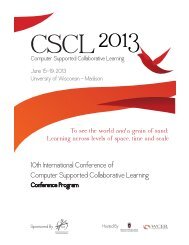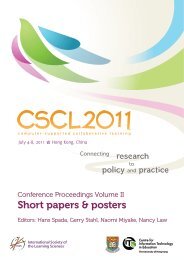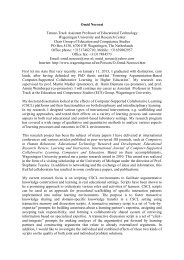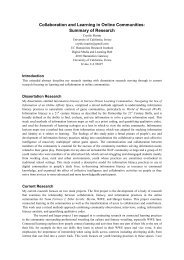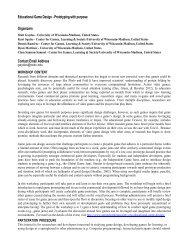Kapur & Bielaczyc, 2012 - ISLS International Society of the Learning ...
Kapur & Bielaczyc, 2012 - ISLS International Society of the Learning ...
Kapur & Bielaczyc, 2012 - ISLS International Society of the Learning ...
You also want an ePaper? Increase the reach of your titles
YUMPU automatically turns print PDFs into web optimized ePapers that Google loves.
Productive Failure<br />
Manu <strong>Kapur</strong><br />
Head, <strong>Learning</strong> Sciences Lab<br />
Associate Pr<strong>of</strong>essor <strong>of</strong> Curriculum, Teaching & <strong>Learning</strong><br />
National Institute <strong>of</strong> Education, Singapore<br />
Jul 04, ICLS <strong>2012</strong><br />
1
Outline<br />
• The case for failure<br />
• Designing for productive failure<br />
• Empirical evidence<br />
• Discussion & implications<br />
• Q&A<br />
2
The case for failure…<br />
Past research:<br />
• Cognitive Strain and Disfluency<br />
• Theory <strong>of</strong> Constructive Failure (Clifford, 1978, 1984)<br />
• Desirable Difficulties (Schmidt & Bjork, 1992)<br />
• Impasse-driven <strong>Learning</strong> (VanLehn et al., 2003)<br />
• Assistance Dilemma (Koedinger et al., 2008)<br />
• Preparation for Future <strong>Learning</strong>; Inventing to<br />
Prepare for <strong>Learning</strong> (Schwartz & Bransford, 1999;<br />
Schwartz & Martin, 2004)<br />
3
What is Productive Failure?<br />
Understand what students know about a novel concept that<br />
<strong>the</strong>y have not been taught yet<br />
Afford opportunities to activate and differentiate prior and<br />
intuitive knowledge….to generate, explore, critique, and refine<br />
representations and solution methods (RSMs) for solving<br />
complex problems<br />
Invariably, such a process leads to failure (in relation to a<br />
desired goal)…<br />
But, this may precisely be <strong>the</strong> locus <strong>of</strong> deep learning… provided<br />
some form <strong>of</strong> structure follows subsequently<br />
4
Designing for Productive Failure<br />
(<strong>Kapur</strong> & <strong>Bielaczyc</strong>, <strong>2012</strong>)<br />
GENERATION &<br />
EXPLORATION<br />
PHASE I<br />
CONSOLIDATION O &<br />
KNOWLEDGE ASSEMBLY<br />
PHASE II<br />
Complex problems<br />
Consolidation<br />
Collaboration<br />
Well-structured<br />
Affective support for<br />
Problem solving OR<br />
persistence Instruction OR<br />
Feedback OR<br />
Explanation, etc.<br />
DELAY OF STRUCTURE<br />
5
Productive Failure (<strong>Kapur</strong>, 2008)<br />
Target Concept: Newtonian Kinematics<br />
N = 309, 11 th -grade physics students in India<br />
Well-structured<br />
Well-structured<br />
Ill-structured<br />
Problems (WSP) Problems (WSP)) Problems (ISP)<br />
Ill-structured<br />
Problems (ISP)<br />
Well-structured<br />
Problems (WSP)<br />
Ill-structured<br />
Problems (ISP)<br />
Compared with WSP groups, ISP groups:<br />
1. Generated multiple representations and methods<br />
2. Engaged in complex interaction patterns <strong>of</strong> explanation, critique,<br />
elaboration<br />
3. Low convergence in <strong>the</strong>ir discussions<br />
4. Poor group performance<br />
5. BUT, better individual performance on both well- and ill-structured<br />
problems
Discussion<br />
1. Can variation in individual or group prior knowledge<br />
explain productive failure?<br />
2. Can variation in group performance explain productive<br />
failure?<br />
3. Effect <strong>of</strong> prior knowledge—individual and group—as well as<br />
group performance not significant<br />
4. Therefore, efficacy seemed to be embedded in <strong>the</strong><br />
complex, divergent, interactional dynamics in <strong>the</strong> illstructured<br />
groups (<strong>Kapur</strong> & Kinzer, 2009)<br />
5. In progress: When Productive Failure fails…<br />
7
The Problem<br />
(Grade 8/9 students)<br />
Year<br />
Mike<br />
Arwen<br />
Dave<br />
Backhand<br />
Ivan<br />
Right<br />
1988 14 13 13<br />
1989 9 9 18<br />
1990 14 16 15<br />
1991 10 14 10<br />
1992 15 10 16<br />
Who’s <strong>the</strong> most 1993 11 11 10<br />
consistent striker? 1994 15 13 17<br />
1995 11 14 10<br />
1996 16 15 12<br />
1997 12 19 14<br />
1998 16 14 19<br />
1999 12 12 14<br />
2000 17 15 18<br />
2001 13 14 9<br />
2002 17 17 10<br />
8
Students’ Ideas<br />
9
Students’ Ideas<br />
10
Students’ Ideas<br />
Frequency <strong>of</strong><br />
years above,<br />
below, and at<br />
average<br />
Consistency =<br />
years at <strong>the</strong> mean /<br />
yearsawayfrom<br />
away <strong>the</strong> mean<br />
11
Sum <strong>of</strong> year‐on‐year deviation<br />
Sum <strong>of</strong> deviations about <strong>the</strong> mean<br />
Average <strong>of</strong> year‐on‐year absolute deviation<br />
12
Core Mechanisms<br />
1. Activation and differentiation <strong>of</strong> prior knowledge<br />
2. Attention ti to critical conceptual features<br />
1. Difference between <strong>the</strong> mean and consistency<br />
2. Difference between a qualitative ti and a quantitative<br />
representation<br />
3. Why must deviations be positive?<br />
4. Why do we add all <strong>the</strong> deviations? Why not multiply <strong>the</strong>m?<br />
5. What is <strong>the</strong> need for a fixed reference point?<br />
6. Why is mean a good fixed reference point?<br />
7. Why must we divide id by n? ? …and so on…<br />
14
Productive Failure vs. Direct Instruction<br />
Target Concepts:<br />
1. Average Speed (<strong>Kapur</strong>, 2010; <strong>Kapur</strong> & <strong>Bielaczyc</strong>, <strong>2012</strong>)<br />
2. Standard Deviation (<strong>Kapur</strong>, <strong>2012</strong>)<br />
Productive Failure<br />
Students generate multiple representations<br />
and solution methods, followed by instruction<br />
Direct Instruction<br />
Teacher explains concept, models problem<br />
solving, uses worked-out examples,<br />
practice and feedback<br />
Dependent Variables:<br />
1) Procedural Fluency<br />
2) Conceptual Understanding<br />
3) Transfer
Summary <strong>of</strong> Key Findings<br />
• PF outperformed DI on conceptual understanding and<br />
transfer without compromising procedural fluency (<strong>Kapur</strong>,<br />
2010, <strong>2012</strong>; <strong>Kapur</strong> & <strong>Bielaczyc</strong>, <strong>2012</strong>)<br />
• The marginal gain <strong>of</strong> providing cognitive support for PF<br />
groups during <strong>the</strong> generation phase was not significant<br />
(<strong>Kapur</strong>, 2011)<br />
• Teachers consistently underestimate students’ ability to<br />
generate RSMs<br />
• Students that seem strikingly dissimilar on general and<br />
math ability (PSLE) appear strikingly similar in terms <strong>of</strong><br />
<strong>the</strong>ir generative capacity (<strong>Kapur</strong> & <strong>Bielaczyc</strong>, <strong>2012</strong>)<br />
• RSM diversity significantly correlated with learning gains<br />
(<strong>Kapur</strong>, <strong>2012</strong>; <strong>Kapur</strong> & <strong>Bielaczyc</strong>, <strong>2012</strong>)<br />
• PF teachers consistently report that <strong>the</strong>y are stressed and<br />
stretched to work with students’ ideas… BUT, <strong>the</strong>y<br />
<strong>the</strong>mselves understood <strong>the</strong> math better…<br />
16
Explaining Productive Failure<br />
• Activation and differentiation <strong>of</strong> prior<br />
knowledge<br />
• Attention to critical features<br />
• critiquing, explaining, elaborating<br />
• Owning…want to see <strong>the</strong> canonical solution<br />
• Becoming flexible and adaptive<br />
• <strong>Learning</strong> about math and what math is about<br />
17
Fur<strong>the</strong>r Questions<br />
1. Exposure to student-generated RSMs<br />
Core mechanism <strong>of</strong> activation and differentiation: Is it really<br />
necessary for students to generate <strong>the</strong> RSMs or can <strong>the</strong>se be<br />
given to <strong>the</strong>m as worked-out examples to study and evaluate?<br />
Is learning from our own failure better than learning from<br />
o<strong>the</strong>rs’ failure, that is, vicarious failure?<br />
2. Attention to Critical Features<br />
Core mechanism <strong>of</strong> attention to critical features: Do students<br />
really need to generate before receiving <strong>the</strong> critical features, or<br />
would telling <strong>the</strong> critical features without any generation work<br />
just as well?<br />
18
Productive Failure vs. Vicarious Failure<br />
Target Concept: Standard Deviation<br />
N = 64, 9 th -grade math students from 2 intact classes<br />
Pre-post, quasi-experimental design<br />
Productive Failure<br />
Students generate multiple representations<br />
and solution methods, followed by DI<br />
four, 50-min<br />
periods<br />
Vicarious Failure<br />
Students study and evaluate studentgenerated<br />
RSMs, followed by DI<br />
four, 50-min<br />
periods<br />
DVs:<br />
1) Procedural Fluency<br />
2) Conceptual Understanding<br />
3) Transfer
Results: PF vs. VF<br />
(Adj.) Post-test Scores by Condition<br />
9.72 9.45 p = .033, η<br />
2 = .07<br />
p =.001, η 2 = .17<br />
546 5.46<br />
4.43<br />
7.9<br />
6.43<br />
P&I Fluency Conceptual Insight Transfer<br />
20
Productive Failure vs. Strong-DI<br />
Target Concept: Standard Deviation<br />
N = 59, 9 th -grade math students from 2 intact classes<br />
Pre-post, quasi-experimental design<br />
Productive Failure<br />
Students generate multiple representations<br />
and solution methods, followed by DI<br />
four, 50-min<br />
periods<br />
Strong-Direct<br />
Instruction<br />
Teacher explains concept with explicit<br />
discussion <strong>of</strong> critical features, worked-out<br />
examples, practice and feedback<br />
four, 50-min<br />
periods<br />
DVs:<br />
1) Procedural Fluency<br />
2) Conceptual Understanding<br />
3) Transfer
Results: PF vs. Strong-DI<br />
(Adj.) Post-test Scores by Condition<br />
PF<br />
Strong-DI<br />
9.67 9.71<br />
p = .005, η 2 = .13<br />
544 5.44<br />
4.46<br />
p = .058, η<br />
2 = .06<br />
7.88<br />
6.63<br />
P&I Fluency Conceptual Insight Transfer<br />
22
Future Work<br />
1. Unpack design components, e.g.,<br />
• Role <strong>of</strong> prior knowledge<br />
• Role <strong>of</strong> teacher<br />
• Role <strong>of</strong> collaboration<br />
2. Examine what kinds <strong>of</strong> support may fur<strong>the</strong>r enhance<br />
<strong>the</strong> generation and exploration phase<br />
3. Examine different ways <strong>of</strong> designing <strong>the</strong> consolidation<br />
and knowledge assembly phase<br />
4. Examine effectiveness in o<strong>the</strong>r domains (e.g., science,<br />
writing, etc.)<br />
5. Examine <strong>the</strong> role <strong>of</strong> productive failure in problem<br />
finding contexts…<br />
t<br />
23
Cognitive Load Theory<br />
“Controlled experiments almost uniformly indicate that when<br />
dealing with novel information, learners should be explicitly<br />
shown what to do and how to do it” (p. 79; Kirschner et al.,<br />
2006)…<br />
Cognitive Load: un-guided or minimally-guided instruction<br />
increases working memory load that interferes with schema<br />
formation…<br />
Substantive empirical support (Sweller & Copper, 1985; Carroll,<br />
1994; Paas, 1992; Klahr & Nigam, 2004)<br />
compared some version(s) <strong>of</strong> a worked example or strong<br />
instructional guidance condition with a pure problem-solving or<br />
discovery condition.<br />
Conclusion: <strong>the</strong>re is little efficacy in letting learners solve<br />
problems pobe sthat attaget target novel concepts…<br />
cepts<br />
24
Cognitive Load Theory<br />
It is not surprising that students in <strong>the</strong> pure problem solving<br />
condition did not learn as much as those in <strong>the</strong> strongly-guided<br />
guided<br />
condition…<br />
But, this do not necessarily imply that <strong>the</strong>re is little efficacy in<br />
letting learners solve novel problems on <strong>the</strong>ir own<br />
To determine if <strong>the</strong>re is such an efficacy, a stricter comparison<br />
is needed:<br />
Direct instruction vs. students first solve novel problems<br />
on <strong>the</strong>ir own followed by some<br />
form <strong>of</strong> structure<br />
25
Cognitive Load Theory<br />
“Any instructional <strong>the</strong>ory that ignores <strong>the</strong> limits <strong>of</strong> working<br />
memory when dealing with novel information or ignores <strong>the</strong><br />
disappearance <strong>of</strong> those limits when dealing with familiar<br />
information is unlikely to be effective” (p. 77; Kirschner et al.,<br />
2006)<br />
Constraints <strong>of</strong> working memory contingent upon:<br />
• novelty <strong>of</strong> information / concept being learnt vis-à-vis<br />
what students know about <strong>the</strong> concept<br />
• interaction between working memory (WM) and long<br />
term memory (LTM)<br />
26
working memory constraints?<br />
How is novelty defined?<br />
canonical: students t do not have <strong>the</strong> canonical<br />
formulation in <strong>the</strong> LTM, <strong>the</strong>refore <strong>the</strong> concept is novel<br />
non-canonical: students may not have <strong>the</strong> canonical<br />
formulation but may have some prior or intuitive ways<br />
<strong>of</strong> thinking about <strong>the</strong> concept in <strong>the</strong> LTM<br />
If so, could we not to design tasks and activity structures to<br />
activate this knowledge in <strong>the</strong> LTM, and<br />
By activating and working with <strong>the</strong>se priors in <strong>the</strong> long-term<br />
memory, leverage <strong>the</strong> “expandable” aspects <strong>of</strong> WM capacity?<br />
27
In ending…<br />
<strong>Learning</strong> vs. performance…<br />
Productive<br />
Success<br />
Unproductive<br />
Success<br />
Productive<br />
Failure<br />
Unproductive<br />
Failure<br />
THANK YOU!<br />
28



